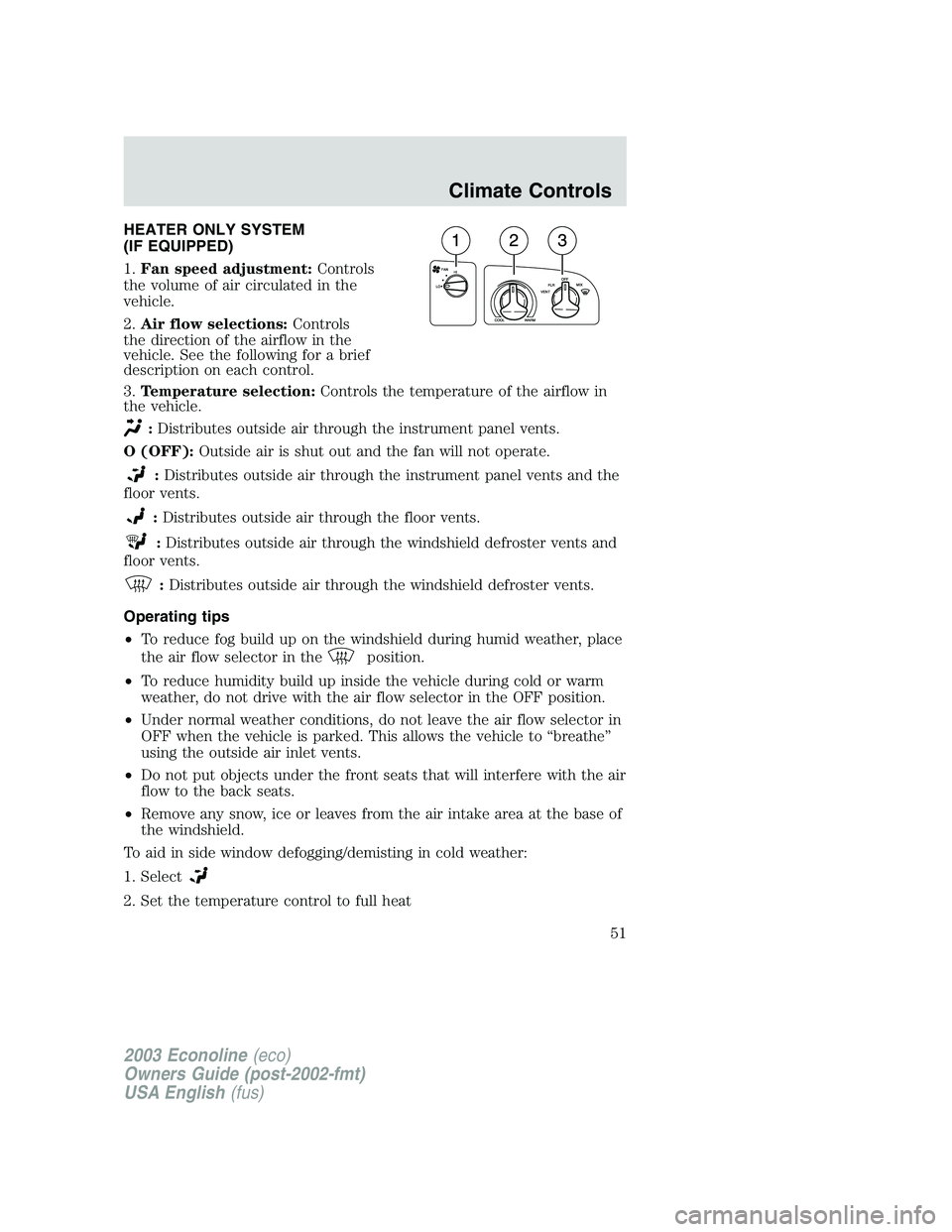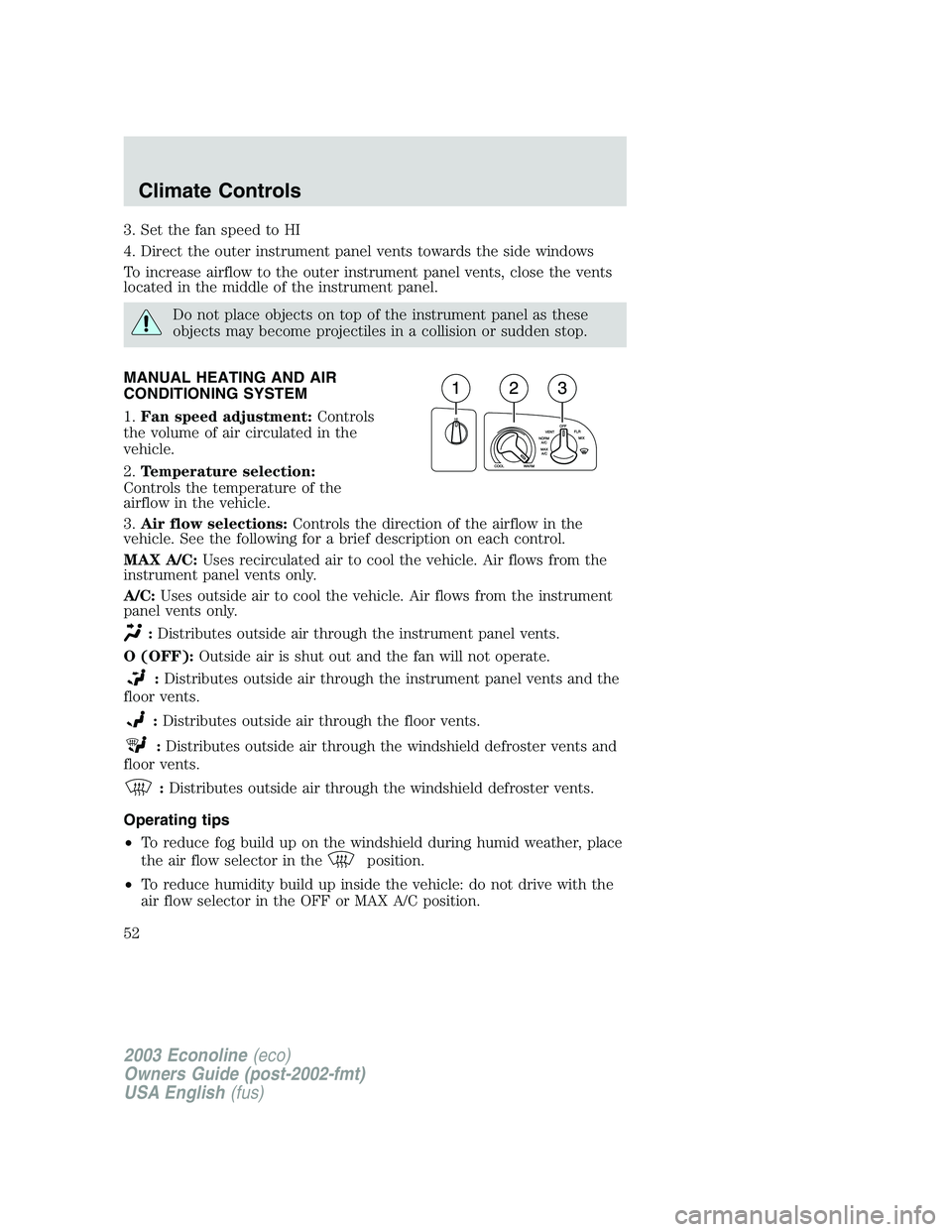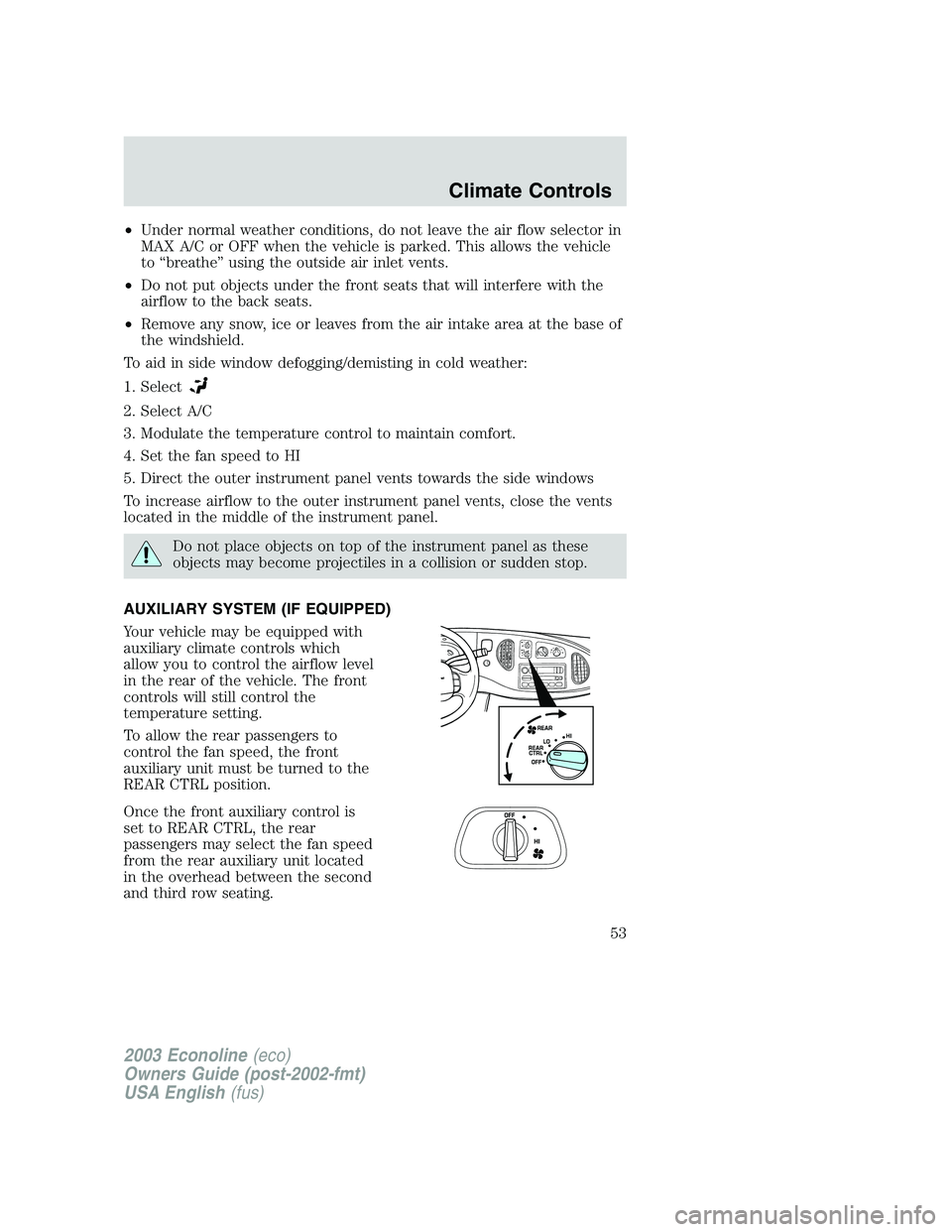2003 FORD E250 climate control
[x] Cancel search: climate controlPage 1 of 232

Introduction 4
Instrument Cluster 10
Warning and control lights 10
Gauges 13
Entertainment Systems 16
AM/FM stereo cassette with CD 16
AM/FM stereo cassette 18
AM/FM stereo with CD 25
Climate Controls 51
Heater only 51
Manual heating and air conditioning 52
Lights 54
Headlamps 54
Turn signal control 55
Bulb replacement 57
Driver Controls 63
Windshield wiper/washer control 63
Steering wheel adjustment 64
Power windows 68
Mirrors 68
Speed control 69
Locks and Security 73
Keys 73
Locks 73
2003 Econoline(eco)
Owners Guide (post-2002-fmt)
USA English(fus)
Table of Contents
Table of Contents
1
Page 51 of 232

HEATER ONLY SYSTEM
(IF EQUIPPED)
1.Fan speed adjustment:Controls
the volume of air circulated in the
vehicle.
2.Air flow selections:Controls
the direction of the airflow in the
vehicle. See the following for a brief
description on each control.
3.Temperature selection:Controls the temperature of the airflow in
the vehicle.
:Distributes outside air through the instrument panel vents.
O (OFF):Outside air is shut out and the fan will not operate.
:Distributes outside air through the instrument panel vents and the
floor vents.
:Distributes outside air through the floor vents.
:Distributes outside air through the windshield defroster vents and
floor vents.
:Distributes outside air through the windshield defroster vents.
Operating tips
•To reduce fog build up on the windshield during humid weather, place
the air flow selector in the
position.
•To reduce humidity build up inside the vehicle during cold or warm
weather, do not drive with the air flow selector in the OFF position.
•Under normal weather conditions, do not leave the air flow selector in
OFF when the vehicle is parked. This allows the vehicle to“breathe”
using the outside air inlet vents.
•Do not put objects under the front seats that will interfere with the air
flow to the back seats.
•Remove any snow, ice or leaves from the air intake area at the base of
the windshield.
To aid in side window defogging/demisting in cold weather:
1. Select
2. Set the temperature control to full heat
2003 Econoline(eco)
Owners Guide (post-2002-fmt)
USA English(fus)
Climate Controls
Climate Controls
51
Page 52 of 232

3. Set the fan speed to HI
4. Direct the outer instrument panel vents towards the side windows
To increase airflow to the outer instrument panel vents, close the vents
located in the middle of the instrument panel.
Do not place objects on top of the instrument panel as these
objects may become projectiles in a collision or sudden stop.
MANUAL HEATING AND AIR
CONDITIONING SYSTEM
1.Fan speed adjustment:Controls
the volume of air circulated in the
vehicle.
2.Temperature selection:
Controls the temperature of the
airflow in the vehicle.
3.Air flow selections:Controls the direction of the airflow in the
vehicle. See the following for a brief description on each control.
MAX A/C:Uses recirculated air to cool the vehicle. Air flows from the
instrument panel vents only.
A/C:Uses outside air to cool the vehicle. Air flows from the instrument
panel vents only.
:Distributes outside air through the instrument panel vents.
O (OFF):Outside air is shut out and the fan will not operate.
:Distributes outside air through the instrument panel vents and the
floor vents.
:Distributes outside air through the floor vents.
:Distributes outside air through the windshield defroster vents and
floor vents.
:Distributes outside air through the windshield defroster vents.
Operating tips
•To reduce fog build up on the windshield during humid weather, place
the air flow selector in the
position.
•To reduce humidity build up inside the vehicle: do not drive with the
air flow selector in the OFF or MAX A/C position.
2003 Econoline(eco)
Owners Guide (post-2002-fmt)
USA English(fus)
Climate Controls
52
Page 53 of 232

•Under normal weather conditions, do not leave the air flow selector in
MAX A/C or OFF when the vehicle is parked. This allows the vehicle
to“breathe”using the outside air inlet vents.
•Do not put objects under the front seats that will interfere with the
airflow to the back seats.
•Remove any snow, ice or leaves from the air intake area at the base of
the windshield.
To aid in side window defogging/demisting in cold weather:
1. Select
2. Select A/C
3. Modulate the temperature control to maintain comfort.
4. Set the fan speed to HI
5. Direct the outer instrument panel vents towards the side windows
To increase airflow to the outer instrument panel vents, close the vents
located in the middle of the instrument panel.
Do not place objects on top of the instrument panel as these
objects may become projectiles in a collision or sudden stop.
AUXILIARY SYSTEM (IF EQUIPPED)
Your vehicle may be equipped with
auxiliary climate controls which
allow you to control the airflow level
in the rear of the vehicle. The front
controls will still control the
temperature setting.
To allow the rear passengers to
control the fan speed, the front
auxiliary unit must be turned to the
REAR CTRL position.
Once the front auxiliary control is
set to REAR CTRL, the rear
passengers may select the fan speed
from the rear auxiliary unit located
in the overhead between the second
and third row seating.
2003 Econoline(eco)
Owners Guide (post-2002-fmt)
USA English(fus)
Climate Controls
53
Page 205 of 232

These Tire Quality Grades are determined by standards that the United
States Department of Transportation has set.
Tire Quality Grades apply to new pneumatic tires for use on passenger
cars. They do not apply to deep tread, winter-type snow tires,
space-saver or temporary use spare tires, tires with nominal rim
diameters of 10 to 12 inches or limited production tires as defined in
Title 49 Code of Federal Regulations Part 575.104(c)(2).
U.S. Department of Transportation-Tire quality grades:The U.S.
Department of Transportation requires Ford to give you the following
information about tire grades exactly as the government has written it.
Treadwear
The treadwear grade is a comparative rating based on the wear rate of
the tire when tested under controlled conditions on a specified
government test course. For example, a tire graded 150 would wear one
and one-half (1 1/2) times as well on the government course as a tire
graded 100. The relative performance of tires depends upon the actual
conditions of their use, however, and may depart significantly from the
norm due to variations in driving habits, service practices, and
differences in road characteristics and climate.
Traction AA A B C
The traction grades, from highest to lowest are AA, A, B, and C. The grades
represent the tire’s ability to stop on wet pavement as measured under
controlled conditions on specified government test surfaces of asphalt and
concrete. A tire marked C may have poor traction performance.
The traction grade assigned to this tire is based on
straight-ahead braking traction tests, and does not include
acceleration, cornering, hydroplaning or peak traction characteristics.
Temperature A B C
The temperature grades are A (the highest), B and C, representing the tire’s
resistance to the generation of heat and its ability to dissipate heat when
tested under controlled conditions on a specified indoor laboratory test
wheel. Sustained high temperature can cause the material of the tire to
degenerate and reduce tire life, and excessive temperature can lead to
sudden tire failure. The grade C corresponds to a level of performance which
all passenger car tires must meet under the Federal Motor Vehicle Safety
Standard No. 109. Grades B and A represent higher levels of performance on
the laboratory test wheel than the minimum required by law.
2003 Econoline(eco)
Owners Guide (post-2002-fmt)
USA English(fus)
Maintenance and Specifications
205
Page 209 of 232

Do not replace your tires with“high performance”tires or larger
size tires.
Failure to follow these precautions may adversely affect the
handling of the vehicle, and increase the risk of loss of vehicle
control, vehicle rollover and/or personal injury.
Tires that are larger or smaller than your vehicle’s original tires may also
affect the accuracy of your speedometer.
SNOW TIRES AND CHAINS
Snow tires must be the same size and grade as the tires you
currently have on your vehicle.
The tires on your vehicle have all weather treads to provide traction in
rain and snow. However, in some climates, you may need to use snow
tires and chains. If you need to use chains, it is recommended that steel
wheels (of the same size and specifications) be used, as chains may chip
aluminum wheels.
Follow these guidelines when using snow tires and chains:
•Use only SAE Class S chains.
•Install chains securely, verifying that the chains do not touch any
wiring, brake lines or fuel lines.
•Drive cautiously. If you hear the chains rub or bang against your
vehicle, stop and re-tighten the chains. If this does not work, remove
the chains to prevent damage to your vehicle.
•If possible, avoid fully loading your vehicle.
•Remove the tire chains when they are no longer needed. Do not use
tire chains on dry roads.
•The suspension insulation and bumpers will help prevent vehicle
damage. Do not remove these components from your vehicle when
using snow tires and chains.
2003 Econoline(eco)
Owners Guide (post-2002-fmt)
USA English(fus)
Maintenance and Specifications
209
Page 226 of 232

waxing .....................................167
wheels ......................................168
wiper blades ............................169
Climate control (see Air
conditioning or Heating) ......51, 53
Compass, electronic ....................65
calibration .................................66
set zone adjustment .................66
Console
overhead ....................................64
Controls
power seat .................................78
Coolant
checking and adding ..............184
refill capacities ................188, 211
specifications ..................215, 218
Cruise control
(see Speed control) ....................69
Customer Assistance ................135
Ford accessories for your
vehicle .....................................171
Ford Extended Service
Plan ..........................................160
Getting assistance outside
the U.S. and Canada ..............164
Getting roadside assistance ...135
Getting the service you
need .........................................158
Ordering additional owner’s
literature .................................165
The Dispute Settlement
Board .......................................161
Utilizing the
Mediation/Arbitration
Program ...................................164
D
Daytime running lamps
(see Lamps) ................................54Dipstick
automatic transmission
fluid ..........................................201
engine oil .................................176
Doors
lubricant specifications ..........215
Driveline universal joint and
slip yoke ....................................201
Driving under special
conditions ..................................123
through water .........................123
E
Emergencies, roadside
jump-starting ..........................152
Emergency Flashers .................136
Emission control system ..........198
Engine ........................................218
cleaning ...................................168
coolant .....................................184
diesel ...........................................6
fail-safe coolant ......................189
idle speed control ...................179
lubrication
specifications ..................215, 218
refill capacities ........................211
service points ..........................174
starting after a collision .........136
Engine block heater .................116
Engine oil ..................................176
checking and adding ..............176
dipstick ....................................176
filter, specifications ........178, 210
recommendations ...................178
refill capacities ........................211
specifications ..................215, 218
Exhaust fumes ..........................116
2003 Econoline(eco)
Owners Guide (post-2002-fmt)
USA English(fus)
Index
226
Page 229 of 232

Safety restraints ....................83–87
belt minder ...............................89
extension assembly ..................92
for adults .............................84–85
for children .........................97–98
lap belt ......................................87
safety belt maintenance ...........92
warning light and chime ..........88
Safety seats for children ..........101
Seat belts
(see Safety restraints) ...............83
Seats ............................................77
child safety seats ....................101
Servicing your vehicle ..............173
Spare tire (see Changing
the Tire) ....................................144
Spark plugs,
specifications .....................210, 218
Special notice
ambulance conversions ..............6
diesel-powered vehicles .............6
utility-type vehicles ....................6
Specification chart,
lubricants ...........................215, 218
Speed control ..............................69
Starting your vehicle ........113–115
jump starting ..........................152
Steering wheel
tilting .........................................64
T
Temperature control
(see Climate control) ...........51, 53
Tilt steering wheel ......................64
Tires ...................................204–206
changing ..........................144–145
replacing ..........................147, 208rotating ....................................207
snow tires and chains ............209
tire grades ...............................205
treadwear ................................205
Towing .......................................126
recreational towing .................134
trailer towing ..........................126
wrecker ....................................157
Traction-lok rear axle ...............118
Transmission .............................119
fluid, checking and adding
(automatic) .............................201
fluid, refill capacities ..............211
lubricant specifications ..215, 218
Trunk ...........................................72
Turn signal ..................................55
V
Vehicle dimensions ...................218
Vehicle Identification Number
(VIN) ..........................................220
Vehicle loading ..........................124
Ventilating your vehicle ...........116
W
Warning lights (see Lights) .......10
Washer fluid ..............................175
Water, Driving through .............123
Windows
power .........................................68
Windshield washer fluid and
wipers ..........................................63
checking and adding fluid .....175
replacing wiper blades .............63
Wrecker towing .........................157
2003 Econoline(eco)
Owners Guide (post-2002-fmt)
USA English(fus)
Index
229